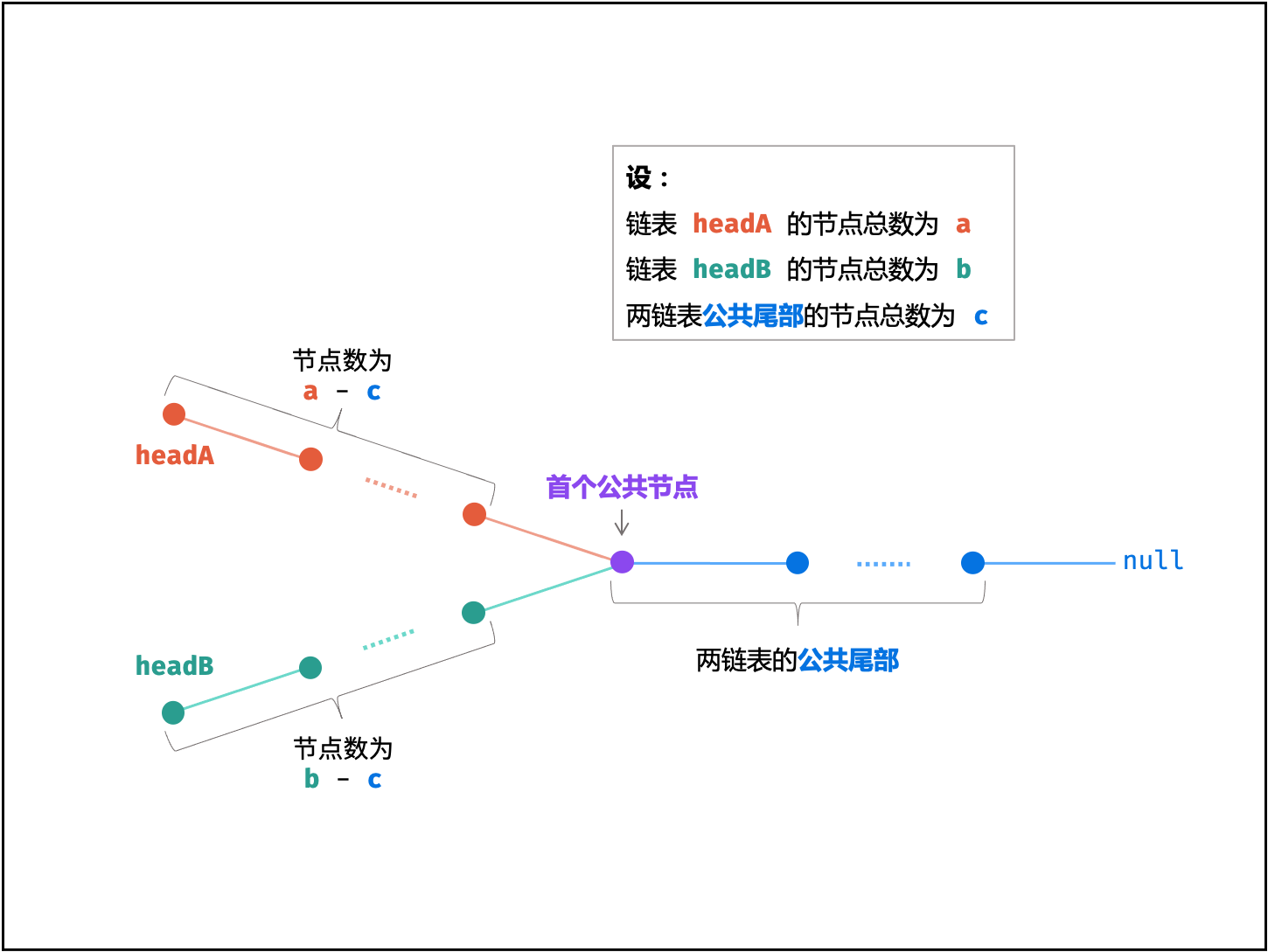1、链表的反转
使用双指针(准确的是三指针记录),分别记录当前,上一节点,下一节点,然后进行反转
public ListNode reverseList(ListNode head) {ListNode p = head, q;head = null;while (p != null) {q = p.next;p.next = head;head = p;p = q;}return head;}
2、相交链表
- 指针遍历完A再遍历B,到达node和B再遍历a一致都是
a + b - c 的 距离
- 如果AB、重合时有两种情况:
- A、B 有重合点
- 无重合点 ,公式中对应C 为 0
public ListNode getIntersectionNode(ListNode headA, ListNode headB) {ListNode A = headA, B = headB;if (A == null || B==null) return null;while (A != B) {A = A != null ? A.next : headB;B = B != null ? B.next : headA;A = A.next != null ? A.next : headB; // 此类写法无法应对无交点的情况B = B.next != null ? B.next : headA;}return A;}
3、环形链表
思想与上类似,都是采用双指针,进行推到,如果双指针遍历的节点相同,则返回true 本题采用快门指针的思想,初始值都为头节点,慢指针走一步,快指针走两步,如果两个节点相同时则返回true,如果fast节点为空,则说明没有环,返回false
public boolean hasCycle(ListNode head) {if (head==null) return false;ListNode slow = head, fast = slow;while (true) {if (fast==null || fast.next==null) return false;slow = slow.next;fast = fast.next.next;if (fast == slow) return true;}}// public boolean hasCycle(ListNode head) {// if (head==null) return false;// ListNode slow = head, fast = slow.next; //虽然这种赋值也可以,但是无法用公式推导// while (slow != fast) {// if (fast==null || fast.next==null) return false;// slow = slow.next;// fast = fast.next.next;// }// return true;// }
4、环形链表 | |
设fast走的路程 f ,slow的路程 s,头节点导环的起点为 a,环的路程 b
- f = 2s
- f = s + nb
所以 s = nb 令fast节点指向 head,当fast节点走到入口时 走的距离为 a ,slow 的距离 nb + a 所以两节点相遇
public ListNode detectCycle(ListNode head) {ListNode fast = head, slow = head;while (true) {if (fast == null || fast.next == null) return null;fast = fast.next.next;slow = slow.next;if (fast == slow) break;}System.out.println(fast.val);System.out.println(slow.val);fast = head;while (slow != fast) {slow = slow.next;fast = fast.next;}return fast;}
4、合并有序链表
递归
当两个链表有一个为 null 时,就可以视为递归最后一层结束标志 在每一层都有
- list1.next = mergeTwoLists(list1.next, list2);
或者
- list2.next = mergeTwoLists(list1, list2.next);
对两个链表进行连接
public ListNode mergeTwoLists(ListNode list1, ListNode list2) {if (list1 == null) {return list2;}else if (list2 == null) {return list1;} else if (list1.val < list2.val) {list1.next = mergeTwoLists(list1.next, list2);return list1;} else {list2.next = mergeTwoLists(list1, list2.next);return list2;}}
迭代
分别定义两个辅助节点,
- preHead : 虚拟头节点记录头节点的位置
- pre : 记录移动轨迹的辅助节点
public ListNode mergeTwoLists(ListNode list1, ListNode list2) {ListNode preHead = new ListNode(-1);ListNode pre = preHead;while (list1 != null && list2 != null) {if (list1.val <= list2.val) {pre.next = list1;list1 = list1.next;} else {pre.next = list2;list2 = list2.next;}System.out.println(pre.val);pre = pre.next;}pre.next = list1 == null ? list2 : list1;return preHead.next;}
两数相加
相加过程中需要确认当前位置的数字和下一位需要进位的值,然后连接前后节点
迭代模拟
public ListNode addTwoNumbers(ListNode l1, ListNode l2) {int nextVar = 0;ListNode preHead = new ListNode(-1); //头节点ListNode head = preHead;while (!(l1 == null && l2 == null)) {int l1var = 0, l2var =0;if (l1 != null) {l1var = l1.val;l1 = l1.next}if (l2 != null) {l2var = l2.val;l2 = l2.next;}ListNode node = new ListNode((l1var + l2var + nextVar) % 10);nextVar = (l1var + l2var+nextVar) / 10;//连接前后节点head.next = node;head = node;}// 如果最后一位需要进位if (nextVar == 1) {head.next = new ListNode(nextVar);}return preHead.next;}
递归
public ListNode addTwoNumbers(ListNode l1, ListNode l2) {return add(l1, l2, 0);}/**返回两个链表相加的头部*/public ListNode add(ListNode l1, ListNode l2, int bit) {if (l1 == null && l2 == null && bit == 0) {return null;}int val = bit;if (l1 != null) {val += l1.val;l1 = l1.next;}if (l2 != null) {val += l2.val;l2 = l2.next;}ListNode node = new ListNode(val % 10);node.next = add(l1, l2, val / 10);return node;}
两两交换链表中的节点
交换相邻两点,需要注意链表的完整
递归
public ListNode swapPairs(ListNode head) {if(head == null || head.next == null){ // 递归返回条件return head;}ListNode next = head.next;//当前节点的下一个值指向下一层递归,注意参数是next.nexthead.next = swapPairs(next.next);next.next = head; //反转return next;}
迭代+多指针辅助
public ListNode swapPairs(ListNode head) {// 如果链表为空或只有一个节点,直接返回if (head == null || head.next == null) return head;// 新建一个虚拟头结点ListNode preHead = new ListNode(-1);// p指向虚拟头结点ListNode p = preHead;// 定义快慢指针,初始值均为头结点ListNode fast = head, slow = head;// 只要快指针和快指针的下一个节点都不为空,就继续遍历while (fast != null && fast.next != null) {// 快指针向后移动一位fast = fast.next;// 定义一个临时节点q,指向快指针的下一个节点ListNode q = fast.next;// 将快指针的下一个节点指向慢指针fast.next = slow;// 将慢指针的下一个节点指向临时节点qslow.next = q;// 将p的下一个节点指向快指针p.next = fast;// p指向慢指针p = slow;// 慢指针和快指针均指向临时节点qslow = q;fast = q;}// 返回虚拟头结点的下一个节点,即新链表的头结点return preHead.next;}
复制带随机指针的链表
由于是深度拷贝,因此在拷贝random指针时,需要确定当前random是否被定义,因此无论采用什么方式,基本上都是将next 与 random 分开拷贝。
public Node copyRandomList(Node head) {if (head==null) return head;Node cur = head;HashMap<Node, Node> nodeMap = new HashMap<>();while (cur != null) {nodeMap.put(cur, new Node(cur.val)); //key 为老节点,value为新建节点,此时新建节点的next和random都未定义cur = cur.next;}cur = head;while (cur != null) {nodeMap.get(cur).next = nodeMap.get(cur.next); // map中V.next指向 K.nextnodeMap.get(cur).random = nodeMap.get(cur.random); //同上cur = cur.next;}return nodeMap.get(head);}


